Acer Aspire V3-571G-9435: The Value Proposition
by Jarred Walton on July 4, 2012 4:25 AM ESTAcer V3-571G Battery Life, Thermals, and Acoustics
I mentioned in the introduction that there were three areas where I feel Acer made some unnecessary compromises. One was the choice of LCD, the second was the choice of hard drive, and the third was their battery capacity. The V3-571G comes with a 6-cell 48Wh battery, and while it’s not the end of the world I still feel a 56Wh or 63Wh battery would have been easy enough to fit into the system without altering the price. Unfortunately, bean counters tend to look for every possible area of savings on budget laptops, and the drop in battery capacity probably shaved off dollar (give or take?) from the Bill of Materials. So how does that affect battery life?

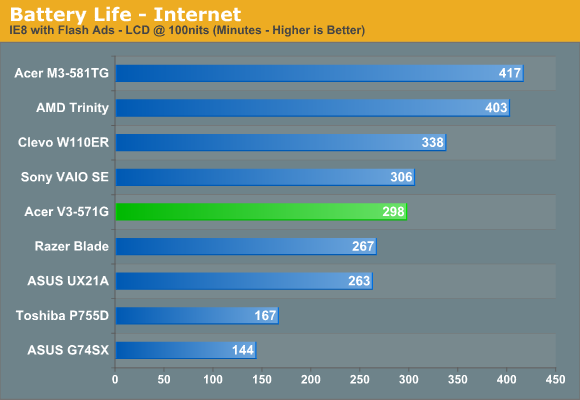
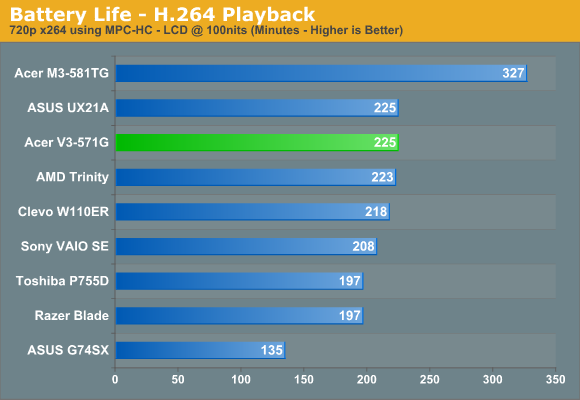
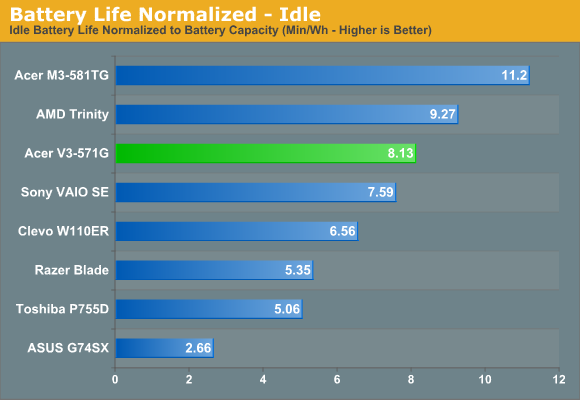
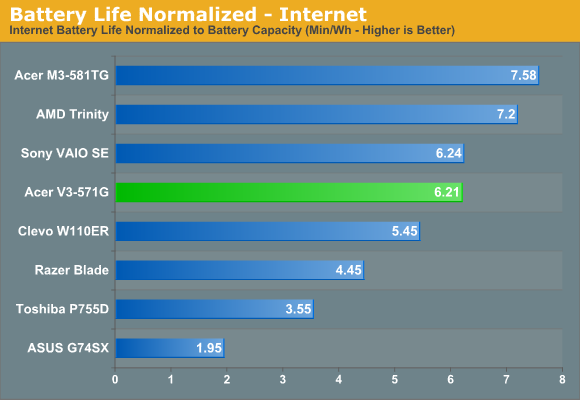
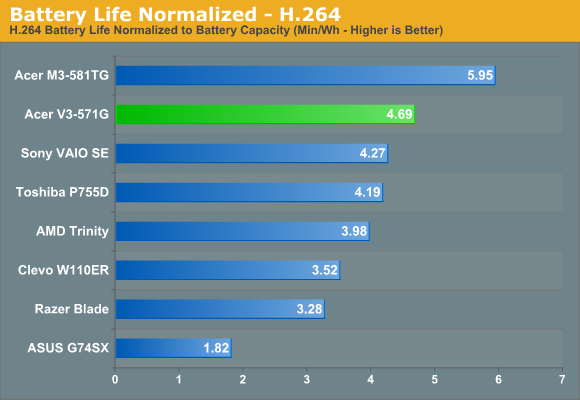
Actually, considering the capacity the battery life isn’t so bad. Maximum possible battery life is 6.5 hours, and typical use battery life for surfing the Internet is still five hours. Anyone interested in using the laptop to watch movies on a longer flight will note that you get just under four hours of H.264 playback from the hard drive, which is only enough to make it through two medium length films. Looking at the normalized battery life results, the Acer V3 rates near the top of the pack, with only the M3 Ultrabook beating it in all three tests and AMD’s Trinity leading in two of the three tests (but losing in normalized H.264 playback). Had Acer equipped the V3 with a 56Wh battery like the M3 or Trinity, we’d be looking at another 30 to 60 minutes of battery life.

Looking at the thermal performance, it’s pretty clear that the V3 chassis provides sufficient cooling for the IVB and Kepler parts. During extended stress testing, the CPU did hit just under 90C on one core, but that was atypical—generally, under load we saw temperatures in the low to mid 80s. The GPU does even better, with a maximum temperature we recorded during stress testing of just 68C.
Noise levels are equally impressive, with idle noise near our testing floor of 30dB, coming in just slightly higher at 31dB. Under heavier CPU or GPU loads, noise creeps up to 33.5dB, with periodic increases to 34.5dB. With a maximum load on the CPU and GPU, we did manage to reach and stay at 35.6dB pretty much as long as we let the testing continue, but that's still pretty quiet for a laptop under full load. The only real concern I have with noise levels is that it appears we’re at maximum fan speed when we’re hitting ~36dB. Why is that a problem? It means that if the laptop happens to be in a more extreme environment (say, Arizona summer weather, with you sitting outside in 110F+ heat), there’s no room for the fan to try and compensate for added heat.
I actually covered the exhaust with my hand for a couple minutes to see if I could get a higher fan speed, with no success (and an uncomfortably hot hand). Interestingly, rather than getting hotter it appears both the CPU and GPU throttled a bit—or at least, I didn’t see core temperatures increase beyond the previously measured highs. This is worrisome as I have a friend with an older Gateway P-series FX notebook that behaves in a similar fashion, only now he’s getting to the point where the 3-year-old notebook occasionally overheats and crashes—something it didn’t do during the first couple years of use. Will the Acer V3 behave similarly in a couple years? Only time will tell, but I’d feel better if there was at least one or two more notches on the fan speed. I’d rather have a loud laptop that runs stably than a quiet laptop that crashes.










88 Comments
View All Comments
weiran - Wednesday, July 4, 2012 - link
Terrible display ruins a laptop.You should refuse to review 15" laptops with a resolution more suited for an 11".
JarredWalton - Wednesday, July 4, 2012 - link
If we refused to review any laptop with a marginal display, we'd be stuck with about 10 to 15 laptop reviews per year -- and that's assuming we could even get all the good display laptops in for review. We would also forego reviews of any laptop that doesn't cost at least $1000. Needless to say, the volume of laptops sold for under $800 is probably an order of magnitude more than the volume of over $1000 laptops sold, so it's an important market to at least look at.duploxxx - Wednesday, July 4, 2012 - link
no one in this budget needs that quad core horse power. Acer would be better of spending the wasted money on build quality or better screen.Penti - Wednesday, July 4, 2012 - link
On the other hand GT 640M wouldn't drive a high-res screen at native resolution. In games that is. But I'm quiet appalled that we can have chassis like this in the Ultrabook and starting configurations for business notebooks price range. Even if you don't have the best displays, or the budget to do all like a super nice case you should at least have a good touchpad and keyboard. Something like a Acer TimelineU M5 wouldn't be more expensive either. So I'm note sure what they are thinking it looks to be a much better notebook, you don't need quadcore notebooks for gaming, the trackpad looks to be better (if they don't fail at it, looks to be a cheap variant on the V3 though) at the M5 and it also comes in a 14" variant.A 2kg dualcore notebook for 800 with GT 640M should be well enough here, and does look better then this. But you loose 1GB of VRAM as well as that quadcore. Yet this doesn't look like a 800 dollar notebook from today and I think it's time to leave the plastic gamer ~800-1000 dollar notebooks behind and let compal and Clevo come up with better computers to fill that need for the OEM's or for them to take the market more seriously and design something decent themselves. Mobile gpus for mid-end performance for gaming obviously exist for half decent power and price range. I thought Acer was trying to clean up their act and please kill all the packard and gateway branding too. Those might have filled up a space in the early 90's, but it's not something you like to remember. Lots of similar stuff isn't the right thing here, if you still like to have budget lineups they will need to be more differentiated from high end models. They should still be decent enough for those that don't like to spend 800-1000 or more too.
JarredWalton - Wednesday, July 4, 2012 - link
Statements like this are so arrogant. "No one in this budget needs that quad core CPU." Really? Who made you the determiner of what every person needs? I know a lot of poor college and high school students that would like to be able to have access to more than just basic dual-core processors. Following your logic, we end up back with the old "640K should be enough for anything" mentality of the DOS era. While most people don't need and won't use the processing power of a quad-core CPU, to say that no one needs it is very narrow minded.bupkus - Wednesday, July 4, 2012 - link
I know a lot of poor college and high school students that would like to be able to have access to more than just basic dual-core processors.Good, but the question is, "can they afford it"?
We have promised to buy a nephew a notebook and had anticipated to pay no more than $500. Now I'm wondering what we can get that will allow this high school grad to do school work and just not even try to provide him gaming or media capabilities.
For that purpose a good monitor seems more significant than an i7 processor. We hope we can find just such a notebook with perhaps a dual core Sandy Bridge processor and even a decent keyboard. Intel HD 3000 display will do just fine. Only the resolution needs a little upgrade.
JarredWalton - Wednesday, July 4, 2012 - link
Obviously there's no single answer to what's most important, but For many of the components, whatever you buy with your laptop is going to be what you're stuck with until you buy a new laptop. If you buy a laptop that doesn't have a discrete GPU, it will generally be inadequate for gaming. You have a better chance of upgrading the display (see the LCD testing section where I discuss what's required) than you have of adding a discrete GPU to a laptop that doesn't come with one. Even swapping out CPUs can be a bit tricky, as you have the potential for locked down BIOS firmware that refuses to support anything besides a couple specific CPUs.Anyway, while I understand that many parents might find the lack of graphics hardware a benefit, if your son/daughter/nephew/niece/etc. ends up not liking the laptop and taking out a student loan to go buy a laptop that they do want, you've wasted money. This definitely happens, as I knew quite a few people back when I was in school that spent $1500+ from their student loans on a new PC that they "needed" for their studies. Of course, I was a CS major so they really did need a computer of some form, but I'm not so sure the 3dfx Voodoo cards were required hardware....
jabber - Wednesday, July 4, 2012 - link
True, however, if you keep reviewing these inferior screens then they will still keep coming.If you said to the manufacturers "No sorry but we consider that spec to be obsolete/inferior to what our users want to buy!" then the message may get across that things have to change.
If you only review 15 laptops a year so what? They are more likely to be ones your readers want to buy after all.
Plenty of other stuff to review than crappy screened laptops after all.
retrospooty - Wednesday, July 4, 2012 - link
"True, however, if you keep reviewing these inferior screens then they will still keep coming. If you said to the manufacturers "No sorry but we consider that spec to be obsolete/inferior to what our users want to buy!" then the message may get across that things have to change"I agree in theory, but the root cause is the issue. Having a site or two or several say that wont change anything. Manufacturers will keep making it as long as people keep buying it.
At least today there are alot more 1600x900 and 1920x1080 options in 13,14 and 15 inch laptops than there has been for the past 3 years. It's starting to shift to higher res.
JarredWalton - Wednesday, July 4, 2012 - link
Exactly. I love how I'm supposed to refuse to review laptops that 90% of people I know outside of AnandTech will buy, and in turn only review hardware that 10% or less of people I know will use. And AnandTech should apparently also only cater to the enthusiasts, rather than trying to build our audience.Articles like this can get noticed by the semi-technical readers that are researching a laptop, and they might end up saying, "Wow, there's a ton of information in that review that I can't find elsewhere. If they think this laptop is fast but cheap -- in price as well as quality -- what do they recommend as an alternative? Maybe I should read more...." We have the potential to increase knowledge as well as readership with mainstream articles like this.
It's always important to see what's going on in the budget oriented market segment when evaluating higher end offerings. I should have a few higher quality (and higher price) laptops in for review shortly, some with good/great screens and some with more of this 1366x768 nonsense.